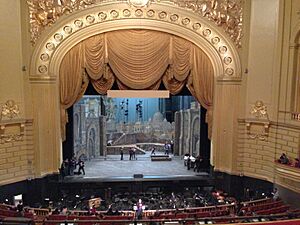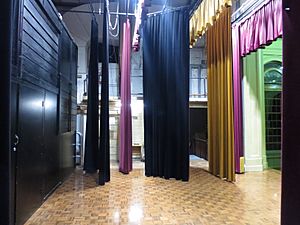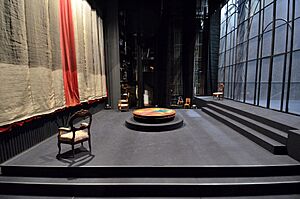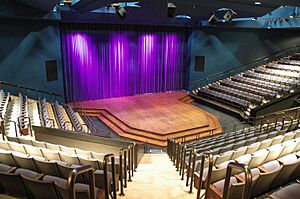Stage (theatre) facts for kids


In theatre and other performing arts, the stage is a special area where shows happen. It's the main spot for actors or performers to act, and it's where the audience looks. A stage can be a raised platform or several platforms. Sometimes, these stages are temporary, but in most theaters, the stage is a permanent part of the building.
There are different kinds of stages. They vary in how they are used and how the audience sits around them. The most common type in Western countries is the proscenium stage. Here, the audience sits on one side, looking at the stage. The other sides are hidden and used by actors and crew. Thrust stages are similar but have a part that sticks out into the audience. This means the audience sits on three sides. In theatre in the round, the audience sits on all four sides of the stage. The fourth type includes stages made just for a show or spaces that are changed into a stage.
Contents
Different Kinds of Stages
Proscenium Stage: The Picture Frame Stage
Since the Italian Renaissance, the proscenium stage has been very popular. You might also hear it called a picture frame stage. Its main feature is a big opening, like a frame, called the proscenium arch. The audience looks through this arch to see the show.
The audience faces the stage directly. The stage is usually a few feet higher than the first row of seats. The audience only sees one side of the scene. This invisible side is often called the fourth wall. The idea of the proscenium arch came from ancient Greek theaters. There, the skênê was a backdrop, and actors performed in front of it.
Early indoor theaters were in places like French tennis courts. Designers used new ideas about perspective. They created amazing scenes with buildings and trees that looked smaller in the distance. Stage floors used to be tilted upwards slightly from front to back. This helped with the perspective and made actors easier to see. Later, audience seats were tilted instead, and balconies were added for better views. By the late 1800s, most stages had flat floors.
Kings and queens wanted fancy shows. This helped pay for bigger and better European court theaters. The proscenium arch was often very decorated. It "framed" the stage picture. To show more backgrounds, architects used ropes and pulleys. These systems helped unroll or lower canvas backdrops. A wooden or steel grid above the stage held pulleys. From these, wooden bars or steel pipes could lower scenery. Heavy pieces were balanced with sandbags. This system needed a tall stage house or loft above the stage. A "full-fly" stage could hide all the scenery above the stage. A "half-fly" stage was smaller and could only hide smaller items. Theaters using these rope systems are called hemp houses. Today, most use counterweight fly systems, which are easier to operate.
The proscenium arch, along with stage curtains called legs, hides the sides of the stage. These sides are called the wings. Theater staff use the wings during shows. They also store scenery and props there. Short curtains across the top of the stage, called teasers, hide the backdrops. The backdrops are stored high above the stage until they are needed.
Sometimes, a stage has an area that sticks out in front of the proscenium arch. This extra area is called the apron. Below and in front of the apron, there is often an orchestra pit. Musicians use this pit during musicals and operas. The orchestra pit can sometimes be covered. This creates more space for actors, bringing them closer to the audience.
Proscenium stages are popular because they have many benefits. You can use lots of props and scenery. Backdrops, curtains, and lighting can create great effects. The audience won't see the ropes or equipment. Actors can enter and exit smoothly, and surprises are possible. Also, actors only need to focus on playing to the audience in one direction.
Theatre in the Round: All Around You

This type of stage is in the middle of the audience. The audience sits on all sides, looking at the stage. This makes everyone feel very close to the action. Actors usually enter and exit through the audience, or from under or above the stage.
"In-the-round" stages need special planning:
- Scenery must not block the view for any part of the audience.
- Backdrops and curtains cannot be used. Directors must find other ways to show where the scene is.
- Lighting design is harder. Actors need to be lit from all sides without blinding the audience.
- Entrances and exits are often through the audience. This makes surprise entrances very difficult. Entrances are usually in the corners of the theater.
- Actors must remember not to turn their backs to any part of the audience for too long. Everyone needs to see and hear them clearly.
Thrust Stage: Into the Audience
A thrust stage sticks out into the audience on three sides. It connects to the backstage area at its upstage end. A thrust stage feels more intimate than a proscenium stage. But it still has a useful backstage area. Actors usually enter from backstage. Some theaters also have special entrances through the audience.
Like an arena stage, the audience on a thrust stage can see the show from three or more sides. If the play uses an imaginary fourth wall, it must be kept on multiple sides. Because the audience sees from different angles, the way actors move (called blocking), props, and scenery need careful thought. This ensures no one's view is blocked. For example, a tall chair placed stage right could block the view of action on stage left.
Black Box Theater: Flexible Space
A black box theater is a simple, plain performance space. It's usually a large square room with black walls and a flat floor. This design allows it to be used in many flexible ways. You can arrange the stage and audience area however you want for each show.
Created and Found Spaces: Anywhere Can Be a Stage
A stage can also be made anywhere a good space is found. For example, a show might happen in a building's basement or on the side of a hill. Street performers might use a city street as their stage. A temporary stage can also be made by changing an environment. For instance, laying a carpet and arranging seats can mark a stage in an open area. The theater group Shakespeare In The Park performs Shakespeare plays in places like Central Park in New York City, which is not a traditional theater.
Stage Directions: Knowing Your Way Around

Areas of the stage have special names. These names help actors and directors plan where actors will move. This planning is called blocking.
To an actor facing the audience, their left and right are opposite to the audience's left and right. To avoid confusion, actors and directors use specific terms. Stage left is the side of the stage on the actor's left when they face the audience. Stage right is on their right. House left and house right refer to the audience's left and right sides. In Germany, stage left and right are reversed, based on the director's view.
Other terms like prompt side (stage left) and off-prompt (stage right) are used in British theaters. These refer to where the stage manager traditionally sits. In French, they use côté cour (square side) for stage left and côté jardin (garden side) for stage right.
The terms front and back can also be confusing. Instead, upstage means the part of the stage furthest from the audience. It also means moving away from the audience. Downstage means the part of the stage closest to the audience, or moving towards them. These terms came from older theaters. In those theaters, the stage floor was often tilted (called a raked stage). So, upstage was actually higher than downstage.
A raked stage can have different slopes. A ten-degree slope is thought to be good for both the audience and actors. A stage for dancing might have a different slope, from three to twenty degrees.
See also
 In Spanish: Escenario para niños
In Spanish: Escenario para niños
- Noh § Stage, classical Japanese theater





